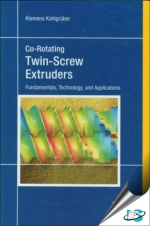Tab Article
Co-rotating screws are used in many branches of industry for producing, preparing and/or processing highly viscous materials. They find a wide variety of applications especially in the plastics, rubber and food industries. Co-rotating twin-screw machines usually have modular configurations and are thus quite flexible for adapting to changing tasks and material properties. Well-founded knowledge of machines, processes and material behavior are required in order to design twin-screw extruder for economically successful operations. This book provides basic engineering knowledge regarding twin-screw machines; it lists the most important machine-technical requirements and provides examples based on actual practice. Better understanding of the processes is emphasized as this is a prerequisite for optimizing twin-screw designs and operating them efficiently. Besides basic functions, such as compounding, the book focuses on the historical development of twin-screws, the geometry of the screw elements (fundamentals, basic patents, patents overview), material properties and material behavior in the machine, fundamentals of feed behavior, pressure build-up and power input, examples of applications for various processing tasks, compounding: tasks, applications, processing zones, potential and limits of modeling, scaling-up various processes, and machine design including drives and materials.


